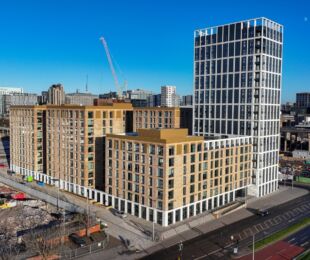
Holmewood House, an independent prep school, occupies a rural 30-acre site near Tunbridge Wells in Kent, including a listed nineteenth-century house, rebuilt to replace a fire-damaged mansion designed by Decimus Burton. Working within an existing masterplan, Studio Partington was commissioned to provide new classrooms, ICT facilities and a multipurpose learning hub and to rationalise circulation across the site, forming a new principal entrance and upgrading the external spaces.
The new two-storey ‘Cloisters’ building is positioned between the principal sandstone mansion, a recently-built classroom block of buff brick and a dark red brick theatre, so the selection of brick as the principal material was intended to help establish continuity and consistency. Inspired by traditional collegiate brick detailing, the new entrance and brick cloister provides a play area for the children to use at break time, a meeting and assembly area, and a primary circulation route between school functions.
The new cloistered courtyard links the circulation routes and provides a social heart to the previously disparate group of buildings. The Hub – the new multipurpose space – is directly accessed from the cloister, and can be configured to accommodate conferences, examinations as well as providing a library. A 13x18-metre clear span was achieved by suspending the first-floor teaching level from the roof structure, enhancing flexibility. Bespoke moveable furniture and bookcases that slide into the walls enable conference use, while providing a recognisable library and learning environment. On the upper floor eight new classrooms are accessed by generously proportioned circulation space, with large windows allowing for plentiful natural light and allowing views of the mansion and landscaped grounds.
The Cloisters has helped to reshape how the school is perceived by uniting previously disconnected buildings to form a coherent whole, at the same time improving accessibility, safety and the learning experience. By restructuring the school’s circulation and establishing a new focal point for staff and pupils, the comparatively modest building delivers significant benefits for the school, helping to raise aspirations and acting as acatalyst for future expansion.
The Cloisters features a combination of antique red multi traditional soft mud stock bricks and slightly darker red multi pavers with an un-sanded texture, which together help tie together the variety of materials that characterises the existing buildings. Brick piers and arches, deep window reveals, soldier courses above windows, built-in brick benches with oak seats and clay pavers laid in a herringbone pattern reference the detail and precedents of the surrounding buildings.
The comparatively simple form and pared-back detailing, which places emphasis on the varied tones and creased texture of the red antique bricks, along with the perceived depth of the facades, serve to instil a harmonious character in the previously confused setting, while the colours respond to the seasonal changes in the leaves of an ancient oak tree in the courtyard.






